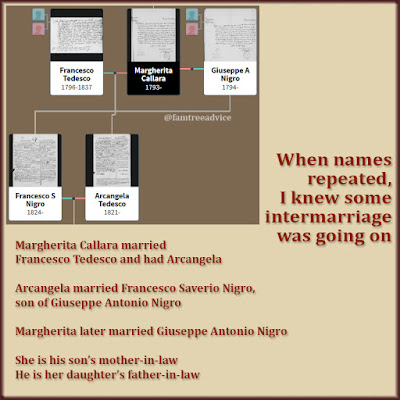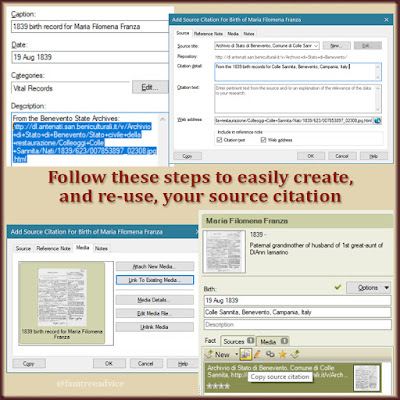Prove to everyone that you've done your genealogy homework.
My husband gave me Family Tree Maker software and an Ancestry subscription as a birthday gift in 2002. It was a big step forward from scribbling my family history in notebooks.
Years later Ancestry.com introduced tree synchronization. It was great for people like me who worked on their desktop and wanted their online tree to show their progress.
Because I work in the desktop software, I never used my online family tree the way so many people do. I never accept hints, and I never add online documents to my online tree. That means you can't click a document in my online tree and go see the original for yourself.
I don't want my family tree to give the impression that I'm not doing quality genealogy research. So, when you visit my family tree on Ancestry.com, you'll see my document images offer a ton of information. I give each image (vital record, census sheet, ship manifest, etc.) detailed facts.
The images themselves offer everything you need to view the original and cite the source. If you've ever taken a close look at a potential cousin's tree, I'll bet you wished they gave you more proof.
Let's say you're looking on any genealogy website at someone's family tree. The tree includes a possible member of your family in the 1930 U.S. census, but you need proof. Is it your relative? You'd know for sure if he's your relative if you could read the street address. But it isn't on the page. Maybe it's on the next page.
That's why adding value to your documents is so important. I like to make sure anyone finding one of my documents can see:
- what the document is
- who the document shows
- when the event happened
- where the document came from
- how to cite the document
- how to view the original document
Vital Record Example
 |
| Carefully planned document annotations make your online tree highly valuable. |
Most of the people in my family tree lived in Italy between the late 1600s and the early 1900s. I find their documents in an online collection of Italian vital records. My Italian vital records use a simple fact format. For example:
- Caption: 1876 birth record for Giovanni Sarracino, recorded in 1898—that tells you what the document is (an 1876 birth record) and who the document shows (Giovanni Sarracino)
- Date: 22 Oct 1876—that tells you when the event (the birth) happened
- Description: From the Benevento State Archives: http://dl.antenati.san.beniculturali.it/v/Archivio+di+Stato+di+Benevento/Stato+civile+italiano/SantAngelo+a+Cupolo/Nati/1898/8287/101687791_00079.jpg.html—that tells you where the document came from (the Benevento State Archives, also known as the Archivio di Stato di Benevento), how to cite the document, and how to view the original document (follow the link)
My more recent relatives have the typical U.S. documents:
- census records
- draft registration cards
- ship manifests, etc.
Each type of document has basic facts I add to the image.
Census Record Example
 |
| The image file's data carries over to Family Tree Maker. Additional facts carry over to Ancestry.com. |
Here is the 1910 census for my great grandfather.
- Caption: 1910 census for Giovanni Sarracino and family, p1 (the family is spread across 2 pages)
- Date: 26 Apr 1910
- Categories: Census
- Description: This is where you'll find a lot of information. I try to follow a format:
- lines 96-100 (where to look on the page for this family)
- 1910 United States Federal Census (the title of the document collection)
- New York / New York / Bronx Assembly District 33 / District 1514 (where to find this page in the larger collection)
- supervisor's district 1, enumeration district 1514, sheet 26B (specific, identifying facts located on the page)
- image 52 of 74 (the exact location of this page in the collection online)
- https://www.ancestry.com/interactive/7884/4449901_00057?pid=18419163 (the URL of the image)
- Source Citation: Year: 1910; Census Place: Bronx Assembly District 33, New York, New York; Roll: T624_1000; Page: 26B; Enumeration District: 1514; FHL microfilm: 1375013 (the source citation provided by the website where I found this document)
- Source Information: Ancestry.com. 1910 United States Federal Census [database on-line]. Lehi, UT, USA: Ancestry.com Operations Inc, 2006 (more information provided by the website where I found this document)
Ship Manifest Example
 |
| Filling in all the details means someone finding your saved genealogy documents has hit paydirt. |
Here's the 1898 ship manifest showing my great grandparents' arrival in America:
- Caption: 1899 immigration record for Giovanni Sarracino and Maria Rosa Saviano
- Date: 24 Jul 1899
- Categories: Immigration/Travel
- Description:
- lines 6 and 7 (Maria Rosa was pregnant with Maria Carmina)
- New York, Passenger Lists, Roll / T715, 1897-1957 / 0001-1000 / Roll 0075
- image 719 of 1062
- https://www.ancestry.com/interactive/7488/NYT715_75-0719
- Source citation: Year: 1899; Arrival: New York, New York; Microfilm Serial: T715, 1897-1957; Microfilm Roll: Roll 0075; Lines: 6-7; Page Number: 222
If you find one of my genealogy documents in an online search, I want you to have every last bit of information you need. You can take it as is, or go to the original location, and cite that source.
Yes, it's a lot of work. I have 6,647 media items in my family tree, and it grows nearly every day. But you've got to keep the long-game in mind. Your family tree is your legacy. You don't want your legacy to be half-baked, incomplete, or unsubstantiated.
My suggestion is to develop your format and stick to it going forward. Then, when you add a new document to someone in your family tree, revisit their previous documents. Give them a facelift while you're there. You'll be constantly polishing your genealogy work, making it better and better. Now that's a legacy.
And speaking of document images:












